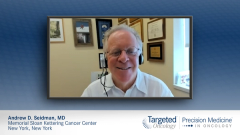
Advances in the Prevention of CIN
Unmet needs and future directions in the prevention and management of chemotherapy-induced neutropenia.
Episodes in this series

Joyce O’Shaughnessy, MD: Pegfilgrastim has made a huge impact. But in certain contexts, it does have downsides. In the dose-dense, if we could use plinabulin instead of pegfilgrastim, we’re not going to get into profound anemia. As you say, you don’t want to put off surgery waiting for marrow to recover. I’d love to see more data because we’ve got the randomized phase 2 trial from ASCO [American Society of Clinical Oncology Annual Meeting] this year with Drs [Douglas] Blayney and [Yuankai] Shi.
Andrew D. Seidman, MD: It sounds like an investigator-initiated trial to me.
Joyce O’Shaughnessy, MD: Yes.
Andrew D. Seidman, MD: Without pegfilgrastim at all.
Joyce O’Shaughnessy, MD: You’re right, Andy. It’s just a single-arm study. Absolutely. Because it’s not feasible otherwise—the AC [doxorubicin hydrochloride, cyclophosphamide] part of it at least. With the paclitaxel, it’s probably feasible. But I’d love that. This is really interesting. We just wait, and we look forward to the FDA’s decision, which I think is coming fairly soon.
Andrew D. Seidman, MD: There’s a PDUFA [Prescription Drug User Free Act] date, maybe in the third or fourth quarter of this year. We need to reimagine what we’ve accepted as the reality. As I said, my patients are talking to one another in the waiting room. They feel like, “I should be able to be cured and not lose my hair. I should be able to be cured and not have significant nausea and vomiting. I should be able to be cured 1 day and have no possibility of having peripheral neuropathy. I should be able to be cured without having to be admitted in the hospital for an infection and have severe bone pain.” The bone pain is interesting. It was in the Protective-2 study in TAC [docetaxel, doxorubicin hydrochloride, cyclophosphamide]. To cite some of the data, all grades of bone pain for TAC [docetaxel, doxorubicin hydrochloride, cyclophosphamide] and pegfilgrastim was 28%, and all grades of bone pain for TAC [docetaxel, doxorubicin hydrochloride, cyclophosphamide] plinabulin was 6.3%. That was in Protective-2.
Joyce O’Shaughnessy, MD: That’s with the pegfilgrastim, right?
Andrew D. Seidman, MD: Right. Is there a protective effect?
Joyce O’Shaughnessy, MD: Yeah. And you’d see by itself. You say, “It doesn’t do the same,” but it’s protective in the context of pegfilgrastim.
Andrew D. Seidman, MD: Right. The addition of plinabulin to pegfilgrastim was associated with 6.3% of incidents of bone pain, and pegfilgrastim and placebo was 28%. That’s another intriguing signal.
Joyce O’Shaughnessy, MD: That’s fascinating. I always attributed that bone pain to its expansion of the marrow, but also probably some degranulation in the marrow with histamine release. That’s 1 of the reasons we did some data about loratadine and others. Somehow, it’s stabilizing the cells, so there isn’t as much degranulation. That’s a remarkable number, actually.
Andy, as always, it’s been fun talking to you. I learn by talking, so this has really been fun for me. As you said, reimagining, stepping back and thinking, “Where are the gaps here? Where could this be useful?” When you start to think about it, it’s like, “This is really interesting.”
Andrew D. Seidman, MD: Yes. When our patients don’t accept business as usual, we shouldn’t either, right?
Dr. Joyce O’Shaughnessy: You got it. That’s right.
Andrew D. Seidman, MD: I always had hope before we both retire that we’d be looking back to the time when we used to give cytotoxic chemotherapy. Unfortunately, despite all the advances with antibodies and small molecules and immuno-oncology, we’re still dealing with cytotoxic chemotherapy and its consequences. For me, this is a good step in the positive direction.
Joyce O’Shaughnessy, MD: Absolutely. It’s such a pleasure, Andy. Thanks so much for being here.
Andrew D. Seidman, MD: Thank you, Joyce.
Joyce O’Shaughnessy, MD: Thank you to our audience for watching this Targeted Oncology™ presentation on precision medicine, a brand-new, super-interesting agent and targets and mechanisms of action. There’s a lot more to learn, with a lot more data to come. We hope you find this agent useful, and you’ll have the heads-up once we get FDA approval, hopefully in the near future. Thanks again.
Transcript edited for clarity.







































